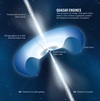Astrophysics Flashcards
(41 cards)
Apparent Magnitude, m
Apparent magnitude is a measure of the brightness of a star in the night sky when it is seen from earth which depends on the intensity of the light received from the star.
Hipparcos Scale
Ranks stars on their brightness from 1 to 6: the lower the number, the brighter the star is
1 is the brightest
6 is the dimmest star visible to the naked eye
Every difference of 5 magnitudes corresponds to 100 times more light
Ix/Iy = 100ςm/5
Absolute magnitude, M
The value of the apparent magnitude if a star is at a distance of 10 parsecs from the observer
Parsec: distance from a star that subtends 1 arc second to the line between the sun and the earth
Light Year: distance travelled by light through space in one year
m - M = 5logd/10
Astronomical Distances
Parsec: distance to a star which subtends to an angle of 1 arc second to the line from the earth
Astronomical Unit: the mean earth to sun distance at 149,597,871km
Metre: distance travelled by light in a vacuum in 1/29979347s
Light Year: distance travelled by light through space in one earth year
(see data booklet for conversions)
Stellar Parallax
The shifting of nearby stars against the background of more distant stars due to the orbital movement of the earth about the sun
As we are travelling in an orbit, stars appear to shift position. The closer an object is, the more apparent the shift is
d=R/θ

Stellar Spectral Classes
O: > 30,000 (He+, He, H)
B: 10,000 - 30,000 (He, H)
A: 7,500 - 10,000 (H, ionized metals)
F: 6,000 - 7,500 (ionized metals)
G: 5,000 - 6,000 (ionized and neutral metals)
K: 3,500 - 5,000 (neutral metals)
M: 2,000 - 3,500 (neutral atoms, TiO)
The temperature is related to absorbtion spectra limited to Hydrogen Balmer absorbtion lines: which is a requirement for atoms in an n = 2 state.
- Heavier stars go further up the main sequence
- Super giants are very bright and large
- Giants are cooler giants and will be red
- White dwarfs are very dim and small
- Stars are much larger and heavier towards the top, and are smaller at the bottom
A star will evolve from the main sequence to become one of the other types on the diagram

Stellar Luminosity
Luminosity is the power output of a star (releasing energy in all directions)
L (watts) = E (joules) /T (seconds)
Inverse Square Law
The energy radiated by a star is spread spherically, hence the intensity of radiation decays as 1/r2
The brightness of a star depends on its luminosity and distance to earth:
B = L/4πr2

Classification of Stars
The stars behave like a black body (perfect absorbers and emitters)
Stars emit electromagnetic radiation in a spectrum of wavelengths, the power emitted changes with the temperature
Stefan’s Law states that the power emitted by a black body depends on its temperature and surface area
P = σAT4
Wien’s Law states that the black-body radiation curve for different temperatures will peak at different wavelengths that are inversely proportional to the temperature
λmax T = 2.9 x 10-3 mK
Supergiants
Radius = 1000 x radius of sun
Very bright - M ranging from: -10 to -5
Huge range of temperatures
Giants
Radius = 10-100 x radius of sun
Brighter than the sun - M randing from: -2 to +2
Cooler than the sun
White Dwarf
Radius = 0.01 x radius of sun
Very dim - M ranging from: +5 to +10
Very hot and small
Star Formation
Star Formation
- A protostar is formed - a gas cloud that is contracting due to its own gravity
- When the gas cloud is contracting, the potential energy is converted to kinetic energy and the temperature increases
- Once the temperature reaches 106 Kelvin, hydrogen fusion is able to occur within the core of the star
- The star must also have enough mass for the temperature to increase to the required magnitude
- Fusion in the core converts hydrogen to helium
- The photosphere surrounding the core, has a lower temperature than the core - 2500 K to 50,000 K

Moving into the Main Sequence
Main Sequence
- Once fusion has occurred, the star becomes stable and joins the main sequence
- The star remains in the sequence for 109 years - large stars remain in the main sequence for a shorter amount of time as they have a higher rate of fusion (they are more luminous and hotter)
- In a stable star, the forces are in equilibrium
- Gravitational field forces act towards the core in all directions
- Fusion created radiational forces that act outwards
- As time goes on, the radiation pressure decreases as the star runs out of fuel, meaning the graviational forces are greater than the radiational forces and it is no longer in equilibrium
Formation of Red Giant
Red Giant
- The formation of a red giant takes about 1/3 the time it spends in the main sequence
- The core will shrink and collapse due to the graviational forces being larger than the radiational forces
- As the core collapse, the temperature increases, meaning there is enough energy for helium nuclei to begin fusing and producing heavier elements (C, O, Be)
- In the outer area of the core, there is a small area that continues to burn hydrogen known as the hydrogen-burning shell
- This causes the photosphere to expand and increase in temperature, and it starts emitting red light, becoming a red giant and exiting the main sequence
- When the helium begins to fuse, the forces will return to equilibrium

White Dwarf Formation
White Dwarf
- A white dwarf will be formed when the star runs out of helium and the core collapses again.
- The temperature increases and starts fusing heavier elements to produce elements up to iron
- The photosphere will expand until the star loses control of it forming a planetary nebula
- If the mass of the core is less than 1.4 x the mass of the sun then the core will stop contracting and turn into a white dwarf
- The temperature increases causing it to be white and the luminosity decreases
Stellar Evolution
- Protostar
- Star
- Star joins main sequence
- Red Giant
- Planetary Nebula
- White Dwarf

Gamma Ray Bursts
Gamma ray bursts occur due to the collapse of supergiant stars to form neutron stars or black holes
- Intense jets of gamma rays have been observed in distant galaxies
- Short-livedbursts (lasting 0.01-1s) are associated with the merger ofneutron starsto form ablack holeor aneutron star falling into a black hole
- Long-lived bursts (10-1000s) are associated with the collapse of a massive star in a supernova
The energy output from a typical gamma ray burst is the same as the total energy output of the sun over its entire lifetime
Black Holes
When the mass of the core is three times the mass of the sun, the star will develop into a black hole
It is so dense that nothing can escape from it, not even light
If the velocity > c, they they will be able to escape the black hole
The event horizon of a black hole is the time where the speed that would be required to escape the black holes graviational pull is greater than or equal to c.
Schwarzchild Radius:
Gives the area around the star where all matter will be engulfed
Rs = 2GM/c2

Supermassive Black Holes
Supermassive black holes are black holes of unimaginable mass that are believed to exist in the centre of galaxies
They can gain enourmous amounts of mass as they draw in matter from orbiting stars
Orbital speeds and distance from galaxies such as Andromeda and the Milky Way suggest they are orbiting a supermassive centre
Occurance of Supernova and the Fate of Massive Stars
Fate of Massive Stars
- Once the mass of the core is greater than 1.4 x mass of the sun, iron will be produced in the core
- Iron is produced via fusion
- Electrons are pushed very close together by the graviational force and they begin reacting with protons
- As electrons are pushed together, density increases to around 1017 kgm-3 which is the density of nuclei leaving a very rigid core
- Any infalling matter will bounce off in an explosion called a supernova
Supernova
- They are very luminous - M from -50 to -20
- The increase in luminosity happens within 24 hours
- This is when some heavier elements can be formed
- Neutron stars are the cores of supernovae, and have a diameter of around 30km
Standard Candle
Standard candles are objects of known absolute magnitude/luminosity that can be used to find its distance from earth to tell us distances to the galaxies it belongs to
Cepheids and type 1a supernova are standard candles
Classification of Supernovae
Classified based on their line absorption spectra
Type I Supernova:
- No H lines
- Luminosity decreases steadily
Type 1a:
- Silicon absorption lines
- Act as standard candles
- Luminosity of 109 x luminosity of sun
- M ranges from -19.3 to + 0.03
- Result from a white dwarf attracting a companion giant star, carbon fuses to form silicon and the star becomes unstable resulting in an explosion
Type 1b:
- Strong He Lines
- Originates from the collapse of a supergiant
Type 1c:
- No H or He lines
- Originates from the collapse of supergiants that have completely exhaisted their supply of helium
Type 2 Supernova:
- Strong H lines
- Luminosity decreases unsteadily

Doppler Effect
The apparent change in frequency and wavelength of a wave caused by the relative motion between the source (star) and the observer (astronomers)
z = v/c
When the wave (source) is moving towards the observer, the frequency increases and the wavelength decreases, and a Blueshift will be seen
- shift in frequency = +v/c
- shift in wavelength = -v/c
When the wave is moving away from the observer, the frequency decreases and the wavelength increases and a Redshift will be seen
- shift in frequency = -v/c
- shift in wavelength = +v/c
∆λ = (v/c) x λ













